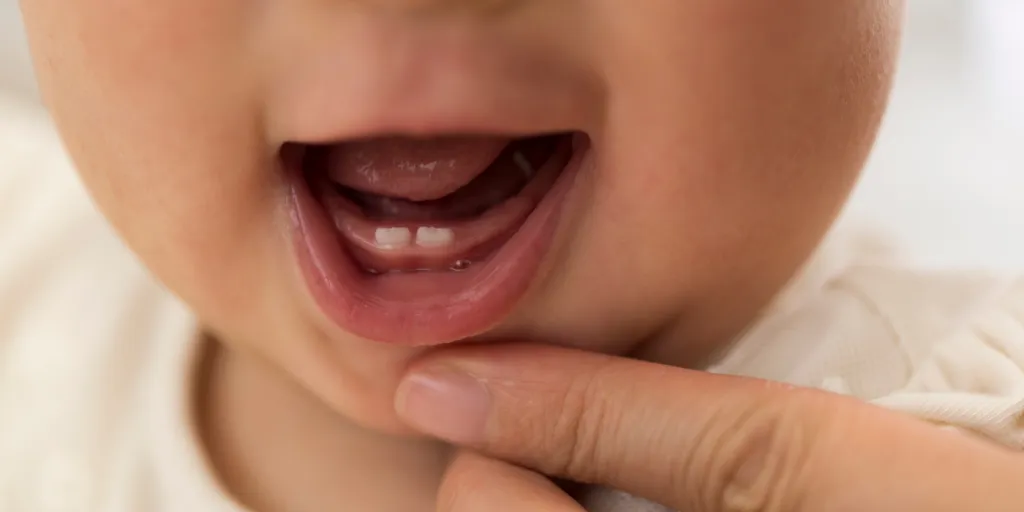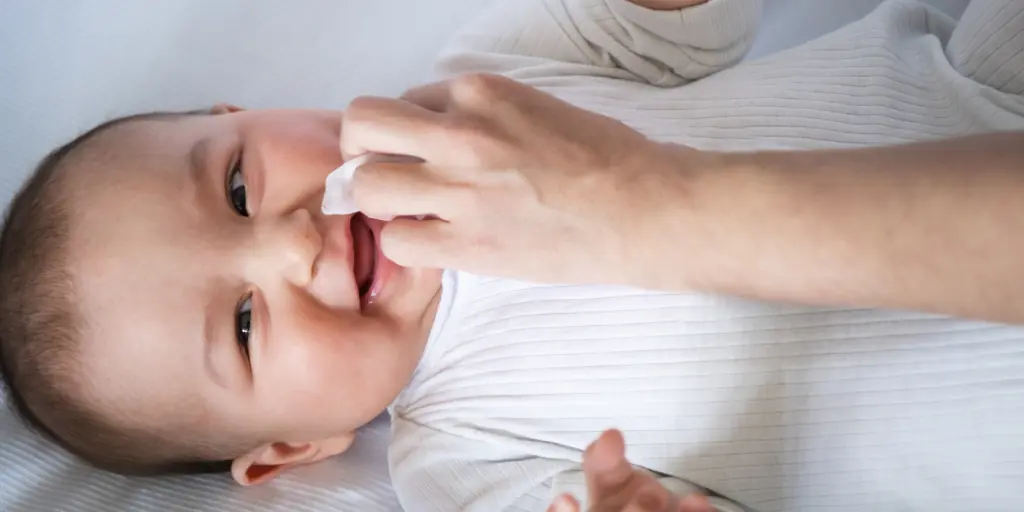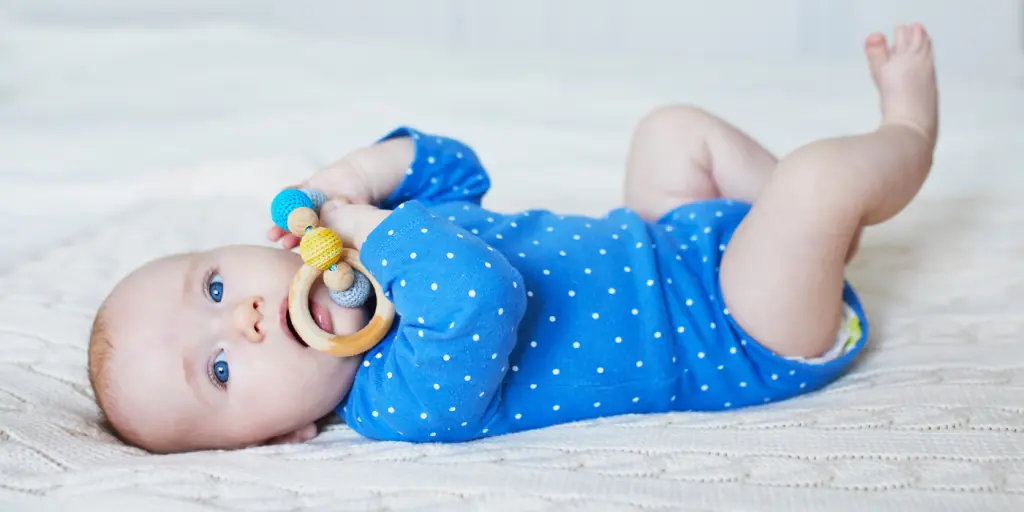Teething is a natural process that every baby goes through, but it can be a challenging time for both the baby and the parents.
One of the common symptoms associated with teething is the appearance of teething rashes on the baby’s skin. These rashes are often caused by the excessive drooling that occurs during teething, which can lead to irritation and inflammation of the skin.
The appearance of teething rashes can be alarming for parents, but it’s important to know that they are generally harmless and can be easily treated.
Teething rashes usually present themselves as redness or dry skin around the mouth, chin, cheeks, and sometimes the neck. In some cases, the rash may also be accompanied by tiny bumps or blisters.
If you notice a rash on your baby’s skin while they are teething, it’s important to keep the affected area clean and dry. You can use a soft cloth to gently wipe away any excess drool, and apply a barrier cream to protect the skin from further irritation.
In more severe cases, a doctor may recommend a mild topical steroid cream to reduce inflammation and itching.

What are Teething Rashes?
Teething rashes are skin irritations that appear on a baby’s face, chin, and neck during the teething process. They are usually caused by excessive drooling, which can irritate the skin and cause rashes.
Teething rashes can also be caused by the rubbing of wet clothing or blankets against the skin, which can further aggravate the rash.
Symptoms of teething rashes include redness, dryness, chapping, and small bumps on the skin. The rash may be itchy and uncomfortable for the baby, causing them to fuss and cry more than usual. In some cases, the rash may spread to other parts of the body, such as the chest or back.
Teething rashes are a common occurrence during the teething process and usually resolve on their own within a few days or weeks.
However, in some cases, the rash may become infected or worsen, requiring medical attention. It is important to monitor the rash closely and seek medical attention if it does not improve or if the baby develops a fever or other symptoms.
Causes of Teething Rashes
Teething rashes are caused by the excessive drooling that occurs when a baby is teething. The increased production of saliva can irritate the skin and cause a rash to develop. The rash can appear on wet skin on the face, chin, neck, chest, and even the diaper area.
During teething, babies tend to put everything in their mouth, including their hands and toys. This can introduce bacteria and germs into their mouth, which can also contribute to the development of a rash.
Additionally, the constant rubbing of the chin and face with their hands can further irritate the skin and exacerbate the rash.
It’s important to note that teething itself does not cause the rash. Rather, it’s the excess saliva and irritation to the skin that leads to the rash. It’s also worth mentioning that some babies may be more prone to developing teething rashes than others, due to differences in their skin sensitivity and immune system.
To prevent teething rashes, it’s important to keep the baby’s skin clean and dry. Wiping the baby’s face and chin frequently can help remove excess saliva and prevent irritation. Applying a barrier cream, such as petroleum jelly, can also help protect the baby’s irritated skin from further irritation.
If the rash becomes severe or infected, it’s important to seek medical attention. A doctor may prescribe a topical cream or ointment to help alleviate the symptoms and prevent further complications.

Symptoms of Teething Rashes
Teething rashes are a common occurrence in babies and toddlers. The rash may appear around the mouth, lips, chin, face, or any area contacted by drool or wet clothes. Here are some common symptoms of teething rashes:
Blotchy, red, or discolored skin
Bumpy or raised skin
Chapped and dry skin
Small, raised bumps
Itching or irritation
Sensitive to touch
Difficult to soothe when crying
These symptoms can be caused by the excessive drooling that occurs during teething. The drool can cause the skin to become irritated, leading to a rash.
The rash may be more severe in some babies than in others, and it may be more noticeable in babies with sensitive skin.
In addition to the symptoms listed above, teething rashes may also be accompanied by other symptoms such as fever, fussiness, and difficulty sleeping. If your baby experiences any of these symptoms, it is important to consult with your pediatrician to rule out any other underlying conditions.
Treatment for Teething Rashes
Home Remedies
Teething rashes are usually mild and can be treated at home with simple remedies. Here are some home remedies that can help prevent teething rash:
Keep the affected area clean and dry by wiping away drool with a soft cloth or tissue.
Apply a barrier cream like petroleum jelly to protect the skin from further irritation.
Use a cold, damp cloth to soothe the rash and reduce inflammation.
Give your baby something to chew on, like a teething ring or a cold washcloth, to help relieve the discomfort of teething.
Best Teething Bib

Teething Bandana with Teether
It’s not hard to see why these bibs are a bestseller- not only do prevent rashes by absorbing all that drool, but they come with a silicone teether attached to soothe those gums
Best Soothing Cream

Fragrance Free Baby Balm
Soothe those teething rashes with this gentle balm designed for sensitive skin; can be used on the whole body.
Medication free pain relief

Mommy’s Bliss Massage Gel
Soothe your little one with this organic massage gel for gums- an excellent day and night routine for your teething little one.
These home remedies are usually enough to treat a teething rash. However, if the rash is severe or does not improve with these remedies, you may need to seek medical treatment.

Medical Treatment for Baby’s Rash
If the teething rash is severe, your doctor may recommend a medical treatment. Here are some medical treatments that may be used:
Topical steroid cream
A cream that reduces inflammation and itching.
Antihistamine cream
A cream that reduces itching and swelling.
Oral antihistamine
A medication that reduces itching and swelling.
These medical treatments should only be used under the guidance of a doctor. If your baby is experiencing severe symptoms or the skin rash itself is not improving, it is important to seek medical attention.
Prevention of Teething Rashes
Teething rashes can be uncomfortable for your baby, but there are steps you can take to prevent them from occurring. Here are some tips:
Keep your baby’s skin dry and clean: Regularly wipe your baby’s face with a clean, damp cloth to remove excess drool. Also, make sure to change your baby’s bibs and clothing frequently to prevent moisture buildup.
Use soft and absorbent bibs: Choose bibs made with absorbent materials, such as cotton, to help keep your baby’s skin dry. Avoid bibs made with synthetic materials, which can trap moisture against the skin.
Moisturize with baby-safe products: Apply a gentle moisturizer to your baby’s skin to help protect it from irritation caused by drool.
Look for products specifically designed for babies, as they are less likely to contain harsh chemicals that can cause rashes.
Use a barrier cream: Apply a thin layer of petroleum jelly or another barrier cream to your baby’s chin and cheeks to help protect the skin from drool.
Be sure to choose a cream that is safe for babies and does not contain any irritating ingredients.
By following these simple tips, you can help prevent teething rashes and keep your baby’s skin healthy and comfortable.
When to See a Doctor
While teething rashes are common and can usually be treated at home, there are some situations where it may be necessary to see a doctor. Here are some signs to look out for:
The rash is spreading rapidly or getting worse, even with treatment.
The rash is accompanied by a fever or other symptoms, such as lethargy or irritability.
The rash is oozing, bleeding, or has pus-filled blisters.
Your baby is having difficulty breathing or swallowing.
If you notice any of these symptoms, it’s important to seek medical attention right away. Your doctor may prescribe a stronger medication or recommend further testing to rule out other conditions.
It’s also important to keep in mind that not all rashes are related to teething. In some cases, a rash may be a sign of an underlying medical condition, such as an infection or allergy. If you’re unsure about the cause of your baby or child’s rash itself, it’s always best to consult with your doctor.
Remember, while teething can be a difficult time for both you and your baby, it’s important to stay vigilant and seek medical attention when necessary.
By taking the proper precautions and staying informed, you can help ensure that your baby stays healthy and happy throughout the teething process.
FAQS on Baby’s Teething Rash
Can teething cause a rash on the body?
Teething itself does not typically cause a rash on the body. However, the excessive drooling that often accompanies teething can lead to a rash around the baby’s mouth, chin, and neck.
It is less common for teething to cause a rash on other parts of the body, though some children experience diaper rash with teething.
What do teething rashes look like?
Teething rashes usually appear as red, irritated skin around the baby’s lips, mouth, chin, and neck. The rash may be slightly raised, bumpy, or have a chapped appearance due to the constant wetness from drooling.
How do I know if my baby has a teething rash?
To determine if your baby has a teething rash, look for the following signs:
Red, irritated skin around the mouth, chin, and neck.
Excessive drooling, which is common during the teething process.
Other signs of teething, such as fussiness, gum swelling, or a tendency to chew on objects.
If you’re unsure if your baby has a teething rash or if the your baby teething rash is caused by another issue, consult with your pediatrician.
Is it a teething rash or eczema?
Teething rash and eczema can appear similar, making it challenging to distinguish between the two. Teething rash is generally localized around the mouth, chin, and neck and is often accompanied by excessive drooling and other teething symptoms.
Eczema, on the other hand, is a chronic skin condition that can affect various parts of the body and is characterized by red, itchy, and inflamed skin.
If you’re unsure whether your baby has a teething rash or eczema, consult your pediatrician for an accurate diagnosis.
Can teething cause a rash on the face?
Teething can cause a rash on the face, primarily around the mouth, chin, and neck due to excessive drooling. The constant wetness can irritate the skin, leading to a rash in those areas.
However, teething rashes are usually not widespread on the face.
How do you treat teething rash on the face?
To treat a teething rash on your baby’s neck and face, follow these steps:
Keep the area clean and dry: Gently wipe your baby’s face with a soft, clean cloth to remove drool and pat the area dry. Avoid rubbing the skin, as it can further irritate the rash.
Apply a barrier cream: Use a gentle, fragrance-free barrier cream or ointment, such as petroleum jelly or zinc oxide cream, to protect the skin from moisture and irritation.
Keep nails trimmed: Keep your baby’s nails trimmed to prevent them from scratching the rash and causing further irritation or infection.
Use bibs: Put a bib on your baby to help catch drool and prevent it from soaking their clothes and irritating the skin.
Consult your pediatrician: If the rash worsens, does not improve, or you suspect it may be caused by something other than teething, consult your baby’s doctor for further evaluation and treatment recommendations.





